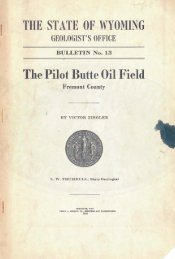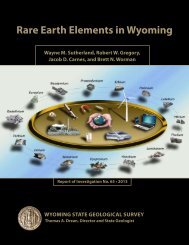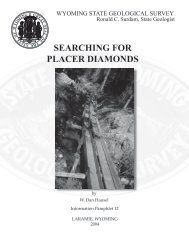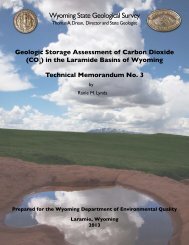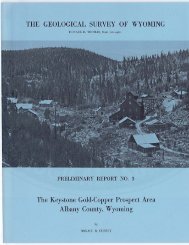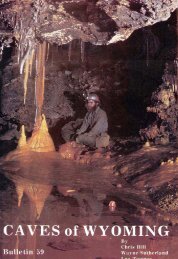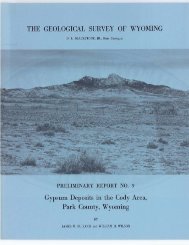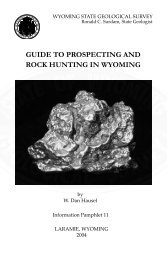The Dinosaurs of Wyoming - Wyoming State Geological Survey ...
The Dinosaurs of Wyoming - Wyoming State Geological Survey ...
The Dinosaurs of Wyoming - Wyoming State Geological Survey ...
You also want an ePaper? Increase the reach of your titles
YUMPU automatically turns print PDFs into web optimized ePapers that Google loves.
CHAPTER VIII<br />
<strong>The</strong> Different Kinds <strong>of</strong> <strong>Dinosaurs</strong><br />
Scientists are not agreed as to whether the reptiles commonly<br />
called <strong>Dinosaurs</strong> do in reality constitute a definite.<br />
natural group. <strong>The</strong> animals are so diverse in size, ranging<br />
from a height <strong>of</strong> a few inches to a length <strong>of</strong> many feet (about<br />
80 feet for the longest). <strong>The</strong>y have specialized, during their<br />
nine millions <strong>of</strong> years, into amphibious, plant-eating animals;<br />
huge carniyorous types; armored reptiles; beaked, planteating,<br />
aquatic and dry-land types, in such an amazing array<br />
that even paleontologists become dizzy trying to figure it all<br />
out.<br />
All <strong>of</strong> these creatures. however, have characters in common,<br />
and we are not yet ready to give up Sir Richard Owen's<br />
group name-Dinosauria. '<strong>The</strong>se common characters are<br />
most readily seen in the arrangement <strong>of</strong> the three hip bones.<br />
or pelvis. <strong>The</strong>se three bones are called ischium, ilium and<br />
pubis; all three <strong>of</strong> 'which take part in the formation <strong>of</strong> the hip<br />
socket-acetabulum-for articulation with the leg bonefemur.<br />
Matthe,Y (1915, p. 27) o'ins the following conyenient<br />
groupings as a basis for further discussion:<br />
"Group I: <strong>The</strong>ropoda-the Carnivorous <strong>Dinosaurs</strong>. Provided<br />
with sharp pointed teeth, sharp claws, bipedal (walking<br />
on two legs-see Frontispiece), with bird-like hind feet, generally<br />
three-toed; the fore limbs adapted for grasping or tearing,<br />
but not for support <strong>of</strong> the body. <strong>The</strong> head is large, neck <strong>of</strong><br />
moderate length, body unarmored.<br />
"<strong>Dinosaurs</strong> <strong>of</strong> this group in America occur in the upper<br />
Jurassic Period-Ornitholestes; and Upper Cretaceous-Tyrannosaurus<br />
and others.<br />
"Group II: Sauropoc1a-·the amphibious <strong>Dinosaurs</strong>. Provided<br />
"'ith blunt-pointed teeth and blunt claws, quadrupedal.<br />
with elephant-like limbs and feet, long neck and small head.<br />
Unarmored American representatives are: Brontosaurus, Diplodocus,<br />
Camarasaurus, and Brachiosaurus, from Colorado and<br />
<strong>Wyoming</strong>. Upper Jurassic and Comanchean.<br />
. "Group III: Predentata-the beaked <strong>Dinosaurs</strong>. Provided<br />
with a horny beak on the front <strong>of</strong> the j'aw, cutting or grinding<br />
teeth behind it. All plant-eaters, with ho<strong>of</strong>s instead '<strong>of</strong> claws,<br />
and many <strong>of</strong> them heavily armored. Mostly three short toes<br />
on the hind foot. four or five on the fore foot.<br />
44<br />
.:<br />
.'




